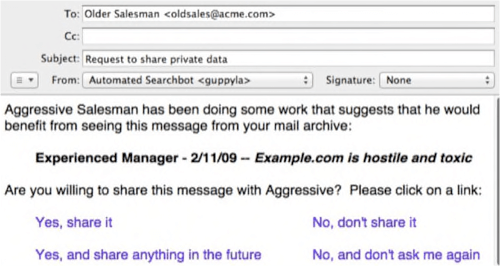Email is dead, according to some high profile figures.

Meanwhile, email use continues to grow steadily, and by some estimates nearly 80% of all business data can be found in email. Yet, even many of email’s greatest fans believe that after nearly 40 years of evolution, email has pretty much settled into its final form. I think they’re wrong – we have only seen the beginning of what email can do.
Much of email’s ongoing evolution is happening behind the scenes. The stability of the email user experience hides a surprising amount of ongoing innovation. In any evolving, complex system, the parts that work best are the least likely to evolve, and will tend to appear static. Today’s email user experience looks a lot like the experience of a quarter century ago, even before the emergence of such major innovations as POP, IMAP, and Webmail. So what’s driving email evolution in 2012? Ironically, it is both spam and cloud computing. Let’s see why.
How Spam Drives Innovation
The problem of spam is thorny, deep, and intractable. The fundamental issue is that Moore’s Law, which has given us all the wonders of the digital age, works in the spammers’ favor. If the good guys work for two years and manage to halve the percentage of spam that gets through, the spammers need only double their output to maintain the same level of access to inboxes.
The good news: there are dozens of different and compatible anti-spam techniques, most of which are not yet in use.
The bad news: Predictably, the industry has chosen the easiest approaches first.
Even these simpler approaches have, like NASA, produced spin-off technologies of wider value, such as filtering and authentication mechanisms. But the real payoff will come when the anti-spam community has to tackle the trickiest set of anti-spam techniques – those that create economic disincentives to spam. This doesn’t necessarily mean a world in which you have to pay to send email; there are far more sophisticated approaches. But it does mean that spam may be the problem that finally produces a global micropayment infrastructure for the Internet, which would be an incredibly valuable spin-off.
Nathaniel Borenstein is chief scientist at Mimecast.com and has contributed to numerous Internet RFCs relating to MIME as well as authoring three software patents on early work on Internet payments in the mid 1990s.
How Email Will Flourish in the Cloud
When a business moves its email to the cloud, it has the opportunity to create, for the first time, an integrated, enterprise-wide archive of most of its business data. A cloud-based email archive becomes an information bank that can be used as infrastructure for previously impossible or even undreamed-of applications.
Generally, cloud email archives will make it possible to perform enterprise-wide, deep analytics that yield systematic insights into security, compliance, internal and external communication, and more. They will also make it possible to proactively and automatically supply users with information that was previously locked up, impossible to find, in the distributed pools of data that constitute the “organizational memory” of an enterprise. These techniques will raise new questions about internal permissions and privacy within an enterprise, but the challenges will be well worth solving for the insights they enable.
For example, cloud archives will make it possible to inspect a message as a user is composing it, and provide, in a real-time sidebar, links to organizational information that might cause the user to change the contents of the message even before he presses the Send button, such as you can see below.

Related mechanisms can even provide users with access to information that they haven’t previously been permitted to see, as you can see below.

Invisible Changes Still Matter
Overall, the lack of visible evolution in the email user experience simply reflects the fact that it’s working pretty well, and there’s not much pressure to change it. But before we conclude that email is fossilized, and its evolution is at an end, we should look at what’s happening behind the scenes, and where industry insiders are devoting their attention.
In the 1990’s, there was a regular trade show called “Email World” devoted largely to user-visible advances in email. That conference is long gone, but instead we have MAAWG, the Messaging Anti Abuse Working Group,, where a few hundred email gurus from around the world converge three times a year to share the latest approaches in the fight against spam and malware. They reflect a part of the email world that is anything but stagnant.
Going forward, it seems safe to predict that email will shed the things it’s worst at, preserve the things it’s best at, and innovate largely in back end functionality. This is a description of a technology that is mature, but not yet set in stone. The story of email remains unfinished.










